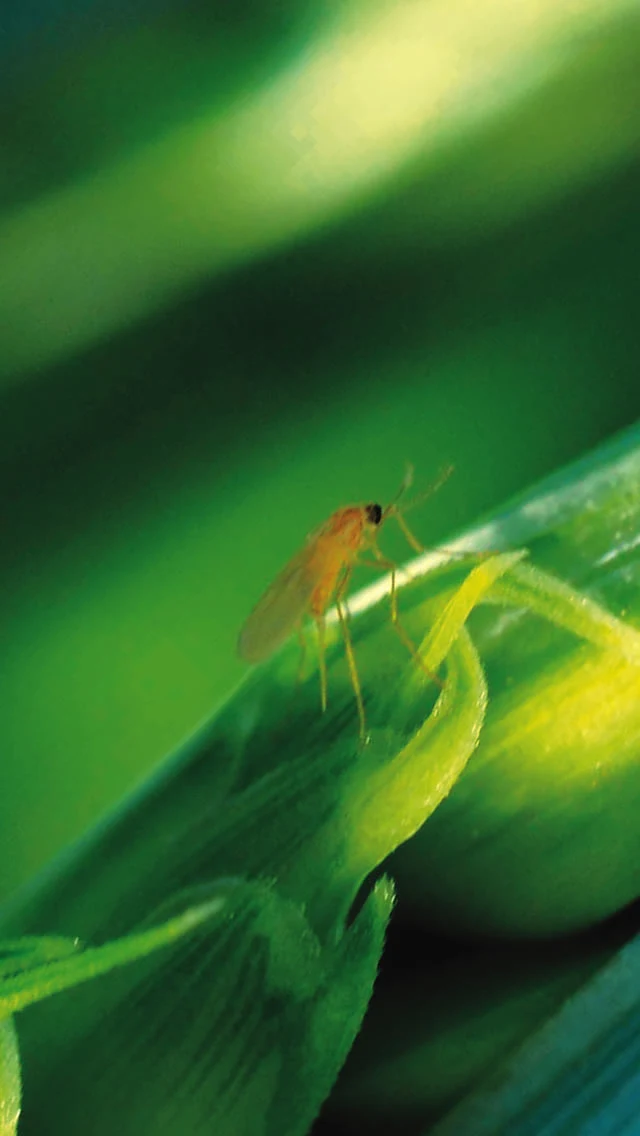
Orange wheat blossom midge
Sitodiplosis mosellana
Identification
Of the 2 species the orange wheat blossom midge is the predominant pest of wheat crops in the UK. Adult flies are orange in colour, 2-3 mm long and are very weak fliers. The larvae are also orange, small and easily identifiable. As the name suggests the yellow wheat blossom midge is yellow as both an adult and a larva. These larvae can be found feeding in the ears of the crop for several weeks after flowering.
Symptoms
The orange wheat blossom midge larvae invade the floret and feed individually on the developing grain which adversely affects both yield and quality. This can be especially damaging for quality wheats.
The larvae of the yellow wheat blossom midge, which emerge earlier than orange wheat blossom midge, tend to feed in numbers on the anthers and stamens leading to blind grain sites, but once pollination has occurred the grain develops normally.
Life-cycle
Midges fly in calm dry conditions when temperatures are above 15 ̊C. Eggs are laid on the insides of florets of wheat ears which can hatch within 4-10 days. When fully fed the larvae drop to the soil. It is thought that orange wheat blossom midge can persist in the soil for 10-15 years and yellow wheat blossom midge for up to 3 years. In suitable conditions the larvae leave the cocoons and move towards the soil surface to pupate.
In mid-summer and in warm and wet conditions the adults emerge from the pupal cases in the soil to complete their life-cycle.
Importance
Reports of damage to crops by orange wheat blossom midge have increased in the past few seasons in all the main arable areas in the UK, and more especially in eastern England, the West Midlands and the Yorkshire Wolds. This is possibly due to the warmer wetter summers of the past few years.
Feeding on the florets can cause blind ears, leading to substantial yield loss as well as loss of quality from shrivelled grain. Once crops reach the flowering stage (GS 61) they are
no longer at risk of damage as the larvae are unable to digest the hardening seed coat.
The yellow wheat blossom midge has greater impact on yield rather than quality and yield losses of up to 25 % have been recorded in trials.
Threshold
Adults can be seen in crops on warm, still summer evenings and a generally agreed threshold for treatment is:
Feed wheat: 1 adult midge for every 3 ears as ears start to emerge.
Milling wheat: 1 adult for every 6 ears as ears start to emerge.
Some organisations provide an in-season service monitoring midge activity by region. In high risk areas in-field pheromone (which catch the males) or sticky traps should be used to assess risk.
Some varieties of wheat, such as Oakley and Robigus, are genetically resistant to orange wheat blossom midge (not yellow wheat blossom midge) attack. They are thought to produce naturally occurring phenolic acids which prevent the larvae from developing and induce a high mortality in newly hatched larvae.
However, more recent research suggests that susceptible varieties also produce phenolic acid when attacked. Although resistant varieties are still attractive as egg laying sites, the
larvae are unable to tunnel into the grain and consequently do not survive.

Yellow wheat blossom midge larva

Yellow wheat blossom midge adult

Yellow wheat blossom midge larvana

Orange wheat blossom midge adult

Orange wheat blossom midge adult


